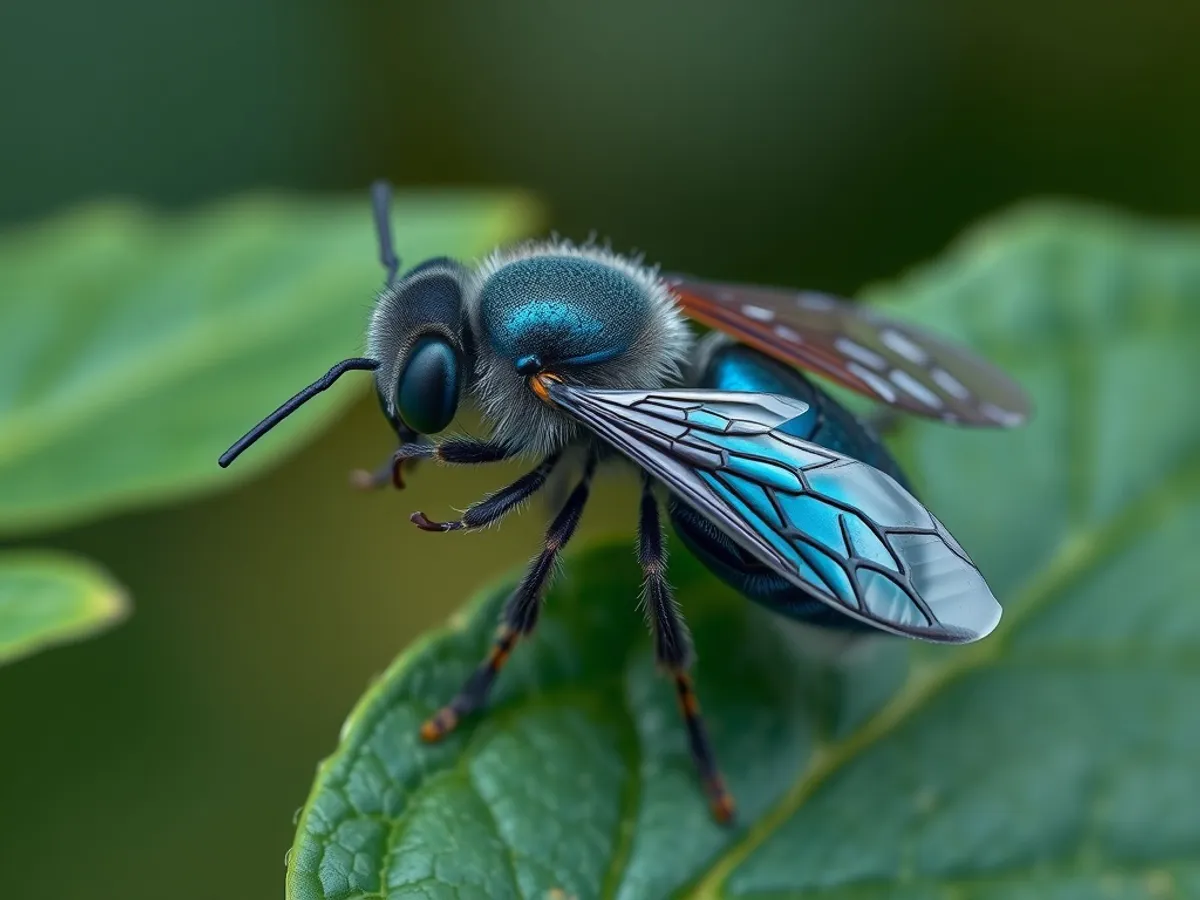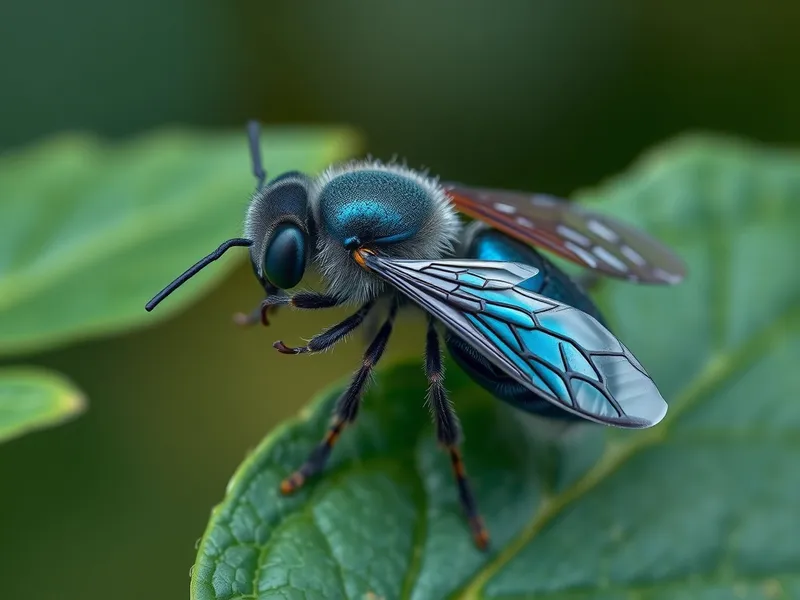
Blue Carpenter Bee
Xylocopa caerulea

Meet the Blue Carpenter Bee
The Blue Carpenter Bee is a strikingly colored, large bee species known for its metallic blue body and fuzzy appearance. Unlike honeybees, these solitary bees do not live in colonies; instead, females bore into dead wood or bamboo to create nests for their offspring. They play an important role in pollination, especially for large flowers, thanks to their robust size and strength. Blue Carpenter Bees are generally non-aggressive and are found in a range of habitats from forests to gardens across Southeast Asia and parts of Australia.
Classification
Invertebrate
Habitat
Tropical and subtropical forests, woodlands, and gardens
Diet
Herbivore
Lifespan
1-2 years
Conservation
Least Concern
Weight
0.5-1 gram
📖Fascinating Facts
Brilliant Blue Hue
The bee's vivid blue color comes from microscopic structures on its exoskeleton that reflect light, not from pigments.
Wood-Boring Behavior
Female Blue Carpenter Bees use their strong mandibles to bore tunnels into dead wood or bamboo, where they lay their eggs.
Effective Pollinators
These bees are important pollinators for many large-flowered plants, including passionflowers and legumes.
📋Detailed Description
The Blue Carpenter Bee (Xylocopa caerulea) is a large, robust bee species notable for its vivid metallic blue coloration, which covers much of its thorax and abdomen. Adults typically measure between 23–28 mm in length, making them among the largest bees in their range. Their bodies are densely covered with short, blue hairs, especially on the thorax, while the abdomen is more sparsely haired and exhibits a metallic sheen. The wings are dark and often display iridescent hues under sunlight. Unlike eusocial bees, X. caerulea is solitary; each female constructs and provisions her own nest. These bees have powerful mandibles adapted for boring into dead wood or bamboo, where they excavate linear tunnels to lay their eggs. Their flight is strong and direct, and they are capable of buzz pollination, a technique that dislodges pollen from flowers with poricidal anthers. The species is diurnal, active mainly during warm daylight hours, and is a key pollinator for various native and cultivated plants. Males are generally smaller, lack stingers, and can be distinguished by their slightly different facial markings. The Blue Carpenter Bee's solitary lifestyle, striking appearance, and ecological role make it a subject of both scientific interest and admiration among naturalists.
💡 Did you know?
Despite their intimidating size and loud buzzing, Blue Carpenter Bees are not aggressive and rarely sting humans.
🔬Research & Sources
🎭Behavior & Social Structure
Blue Carpenter Bees are solitary and territorial, with females aggressively defending their nesting sites from intruders, including other females. They are primarily nectarivorous, foraging on a wide range of flowering plants, with a preference for large, open or tubular flowers such as those of the Fabaceae and Malvaceae families. Their foraging behavior is characterized by rapid, purposeful flights between floral resources, and they are capable of buzz pollination, which is crucial for certain crops and wildflowers. Males patrol territories near nesting sites or favored flowers, engaging in aerial displays to deter rivals and attract mates. Daily activity peaks during mid-morning and early afternoon, coinciding with optimal floral nectar production. At night, bees rest within their nests or in sheltered locations. Females exhibit nest fidelity, often reusing or expanding existing tunnels. Social interactions are limited, but occasional encounters occur at abundant food sources.
👶Reproduction & Life Cycle
Reproduction in Xylocopa caerulea is seasonal, typically coinciding with the onset of the rainy season when floral resources are abundant. Males establish territories and patrol for receptive females. After mating, females seek suitable dead wood or bamboo to excavate nests, using their mandibles to bore tunnels up to 30 cm long. Within each tunnel, the female constructs a series of brood cells, each provisioned with a mixture of pollen and nectar as food for the developing larva. An egg is laid in each cell, which is then sealed with a partition of chewed wood fibers. The development from egg to adult takes approximately 6–8 weeks, depending on temperature and food availability. There is no parental care beyond provisioning; larvae develop independently within their sealed cells. In some cases, newly emerged adults may overwinter in the natal nest before dispersing.
🛡️Adaptations & Survival
Xylocopa caerulea exhibits several adaptations for its solitary, wood-nesting lifestyle. Its robust mandibles are specialized for boring into hard substrates, allowing access to nesting sites unavailable to many other bees. The dense blue setae (hairs) on the thorax may play a role in thermoregulation and pollen collection. Their large body size enables them to forage on flowers with deep corollas and perform buzz pollination, which vibrates pollen loose from specialized anthers. The metallic blue coloration may serve as aposematic (warning) signaling to deter predators, although this is debated. Females possess a strong sting used in nest defense, while males are stingless. Their ability to utilize a wide range of nesting substrates and floral resources contributes to their ecological success.
📚Research Sources
🎨Cultural Significance
In several Southeast Asian cultures, the Blue Carpenter Bee is admired for its striking appearance and is sometimes considered a symbol of strength and industriousness. Its presence in gardens is often welcomed due to its role in pollinating ornamental and crop plants. In some regions, traditional beliefs associate blue bees with good fortune or protection against evil spirits. There are no significant records of the species being used in traditional medicine or crafts, but their nests are occasionally studied by local naturalists and entomologists.
🔬Recent Research & Discoveries
Recent research has focused on the pollination ecology of X. caerulea, particularly its effectiveness in buzz pollination for crops like tomatoes and eggplants. Studies have also examined its nesting preferences, showing a marked adaptability to both natural and anthropogenic substrates. Genetic analyses are underway to clarify the phylogenetic relationships within the Xylocopa genus, with X. caerulea serving as a model for studying the evolution of solitary versus social behaviors in bees. Conservation studies highlight the importance of maintaining dead wood in managed landscapes to support carpenter bee populations. There is also increasing interest in the potential impacts of climate change on their phenology and distribution.
🎥Wildlife Videos

STUNG by a BIG BLUE Bee!
How will the sting of this big BLUE bee compare to the huge BLACK bee? Watch to find out! Moments after experiencing the sting ...
Brave Wilderness

BITTEN and STUNG by a BLUE BEE!
This BLUE bee tears into me! Moments after experiencing the sting of the Borneo's giant black carpenter bee, I found and caught ...
Mark Vins

The life of Carpenter Bees
A wildlife documentary produced by The National Zoological Garden in South Africa about the life of Carpenter Bees.
NATIONAL ZOOLOGICAL GARDEN, PRETORIA Official site

Children of the Sun – Wild Bees
Bees and butterflies play an important role in the pollination of plants and the production of crops for human and animal ...
Free High-Quality Documentaries

Discovering the Blue Carpenter Bee: Nature's Metallic Jewel | A Mesmerizing Journey #nature
Embark on a captivating adventure into the enchanting world of the Blue Carpenter Bee, Xylocopa cerulean, a remarkable insect ...
Wisdom Reality Quest

What's inside a carpenter bee nest?
Many people are familiar with the large carpenter bees that are common across North America, but have you ever seen inside a ...
The Bees In Your Backyard
🌍Habitat Information
The Blue Carpenter Bee typically inhabits Tropical and subtropical forests, woodlands, and gardens environments. Blue Carpenter Bees have adapted to their environments with specialized features and behaviors.
Primary Habitat:
Tropical and subtropical forests, woodlands, and gardens
More detailed habitat information will be available soon.
🛡️Conservation Status
The Blue Carpenter Bee is currently classified as Least Concern. Conservation efforts are crucial for preserving this species for future generations.
Common Threats:
- 🏠Habitat loss and fragmentation
- 🌡️Climate change impacts
- 🎯Hunting and poaching
- 🏭Human-wildlife conflict
⚠️Threats & Conservation Challenges
While currently listed as Least Concern, Blue Carpenter Bees face several localized threats. Habitat loss due to deforestation, urbanization, and the removal of dead wood or bamboo reduces available nesting sites. Pesticide use in agriculture and gardens can negatively impact populations through direct toxicity and reduction of floral resources. Competition with introduced bee species and nest parasitism by other insects (such as certain wasps or cleptoparasitic bees) also pose challenges. Climate change may alter the phenology of flowering plants, potentially disrupting foraging and breeding cycles. Despite these threats, the species remains widespread and adaptable, but continued habitat degradation could lead to future declines.
🔬Scientific Classification
Scientific Name
Xylocopa caerulea
Classification Hierarchy
🔍 About Taxonomic Classification
Taxonomic classification is a hierarchical system used by scientists to classify and organize living organisms based on shared characteristics and evolutionary relationships.
The system moves from broad categories (Kingdom) to increasingly specific ones, with each animal's scientific name typically consisting of its Genus and species.
📝Community Notes
Share your observations and insights about the Blue Carpenter Bee with our community of wildlife enthusiasts.
Join Our Community
Sign in to share your observations and connect with fellow wildlife enthusiasts.
Sign In to ContributeNo community notes yet
Be the first to share your observations about the Blue Carpenter Bee!
Explore Blue Carpenter Bee
Select a tab above to learn more about this amazing animal.
📸Photo Gallery
No photos available for this animal yet.
🌟Discover More Wildlife
Continue your journey of discovery with more fascinating animals from our database
